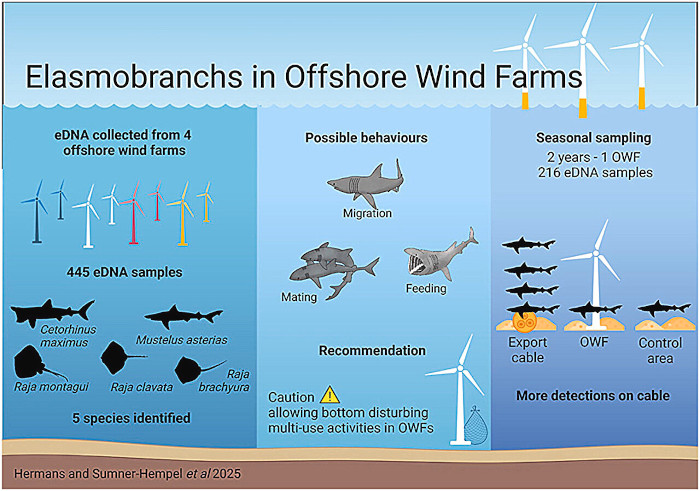Sharks and rays found using offshore wind farms as habitat
A new study by Wageningen University & Research shows that offshore wind farms not only produce energy, but may also contribute to the protection of marine life. Several shark and ray species were detected in and around Dutch wind farms based on traces of DNA in the seawater (eDNA).
The findings have been published in Ocean & Coastal Management.
For the first time, scientists from Wageningen University & Research have been able to confirm the active presence of elasmobranchs within Dutch wind farms through eDNA traces in seawater. The study combined new fieldwork with data from The Rich North Sea Programme. In total, 436 seawater samples were collected, enabling researchers to detect species that had passed through an area without the need for physical capture.
"We're trying to understand whether these animals are actually using the wind farms as habitat, or whether they're being displaced by them," says Annemiek Hermans, Ph.D. candidate at Wageningen University & Research.
Five different shark and ray species were detected in four offshore wind farms: Borssele, Hollandse Kust Zuid, Luchterduinen, and Gemini. The Thornback Ray (Raja clavata) was the most frequently observed species, occurring year-round in three of the sites. Remarkably, Basking Sharks (Cetorhinus maximus)—a large, migratory species—were detected during winter in Hollandse Kust Zuid, providing insight into their seasonal movements.

Other species identified include the Starry Smooth-hound (Mustelus asterias) and the Blonde Ray (Raja brachyura), both found across multiple seasons and sites.
Trawling and other forms of seabed-disturbing fishing are prohibited within offshore wind farms, allowing benthic ecosystems to recover. Researchers believe that these more stable habitats could benefit vulnerable species such as elasmobranchs. "We must tread carefully," Hermans cautions. "If we start allowing bottom trawling in these areas, we risk losing the very protection these zones may offer."
The use of eDNA is a promising, noninvasive tool for marine ecology. "It's like finding a fingerprint in the water," Hermans explains. "Even if you don't see the shark, the DNA tells you it's been there." The method is fast, cost-effective, and animal-friendly, opening up new possibilities for biodiversity monitoring in challenging marine environments.
The findings provide valuable insights for marine spatial planning and policy, particularly as the EU pushes forward with initiatives such as the Habitats Directive and the new Nature Restoration Law. The study explores how offshore energy infrastructure might be integrated with marine conservation strategies, offering potential win-wins for biodiversity and renewable energy.
Hermans is conducting this study as part of the six-year ElasmoPower project, led by Wageningen University & Research. The project investigates whether electromagnetic fields from subsea power cables in offshore wind farms affect elasmobranch behavior, as these species rely on electrosensory perception for hunting and navigation. The work combines lab experiments with field studies using underwater cameras, sensors, and molecular techniques.
Wageningen University
7 May 2025
More Information: Annemiek Hermans et al., "Elasmobranchs in offshore wind farms," Ocean & Coastal Management (2025). DOI: 10.1016/j.ocecoaman.2025.107671.
Share this story








